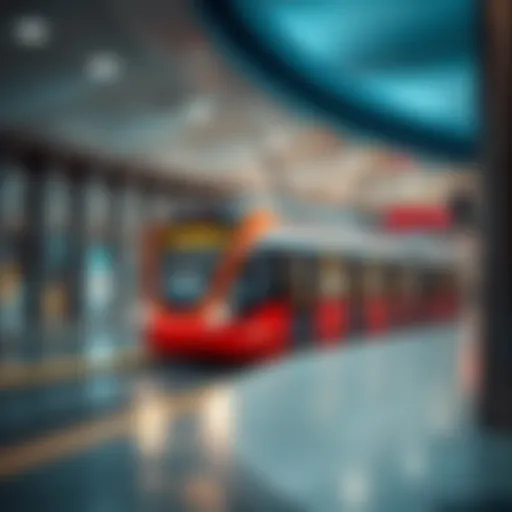Metro Access Insights Near International City, Dubai


Intro
The growth of urban infrastructure directly influences property values and investment prospects. In a vibrant city such as Dubai, metro access serves as a significant catalyst for development, especially in emerging neighborhoods like International City. Tucked away in the southeastern quadrant of Dubai, this area is not only a haven for residents but also a ripe opportunity for investors looking to capitalize on the evolving metropolitan landscape.
Understanding the nuances of metro access can be the key to making informed decisions in the Dubai real estate market. This article will explore the implications that metro stations near International City have for residents and investors alike. By analyzing various metro lines, their connectivity, market trends, and lifestyle enhancements, we aim to provide a comprehensive understanding of the opportunities that lie within this burgeoning suburb.
Investment Opportunities
Top Neighborhoods for Investment
Metro accessibility can dramatically shift the attractiveness of neighborhoods. In the context of International City, several areas stand out for their investment potential. Key neighborhoods include:
- Dragon Mart Area: Known for its bustling commercial activities and proximity to the metro, this area is attracting both businesses and residents. Investors are keen on properties that promise high rental yields due to the constant foot traffic.
- Al Warsan: This neighborhood offers a blend of residential and commercial properties. The ongoing development of metro stations here enhances accessibility, making it a prime target for investors looking for long-term growth.
- Dubai Silicon Oasis: Slightly farther from International City but linked to the metro, this tech-focused area is becoming increasingly popular among young professionals, offering a steady market for rental properties.
Upcoming Developments to Watch
With the Dubai government constantly pushing for innovation and modernization, upcoming developments near metro lines promise exciting prospects. A few noteworthy projects include:
- The Dubai Logistics City: An extension of the metro will connect this logistic hub to International City, making it an attractive residential area for professionals working in logistics and trade.
- New Metro Stations: Planned stations will enhance connectivity to key areas such as Downtown Dubai, broadening the appeal of International City for those commuting to work or leisure.
Market Trends
Current Market Analysis
The current market around International City is witnessing rising demand fueled by improved connectivity. Real estate prices have started gaining traction, reflecting the overall optimism surrounding the metro expansion. According to recent reports, more investors are showing interest in this region as new apartments and townhouses flood the market.
Future Projections and Trends
Looking ahead, forecasts indicate that property values in International City will continue to rise as more metro connections are established. The potential for higher returns on investment is significant. As the city expands, areas once deemed less desirable can transform into hotly-sought residential zones, especially with the enhanced public transport options available to residents.
"Metro access not only improves the convenience of daily commuting but also uplifts property values in surrounding neighborhoods, making them desirable for investors."
Prolusion to Metro Connectivity
In today's fast-paced world, efficient transportation is the lifeblood of urban environments. Metro connectivity is pivotal, providing not just a means of travel but also shaping the landscape of cities. As we explore the metro access near International City in Dubai, the implications stretch from daily commuting ease to potentially elevating property values, making it an indispensable facet of modern urban planning.
Significance of Transportation in Urban Development
Transportation is vital for urban growth and sustainability. It serves as a backbone that connects various parts of a city, allowing people to traverse their daily lives with greater ease. The role of metro systems cannot be overstated—it alleviates congestion, reduces travel times, and minimizes environmental impact. For a place like Dubai, known for its rapid development and increasing population density, a robust metro system stands as a key player in maintaining the smooth functioning of the city.
Key aspects of transportation significance include:
- Economic Growth: Well-connected areas tend to attract businesses and investments.
- Environmental Benefits: Increased public transport use leads to lower emissions compared to personal vehicles.
- Social Inclusivity: Metro systems offer affordable travel options, widening access for all socioeconomic groups.
With International City being a focal point for diverse demographics, enhancing its metro connectivity will likely spur overall development in the region.
Overview of International City’s Location
International City, nestled in the southeast of Dubai, is strategically positioned near major highways and residential areas. This locale provides an ideal base for both residents and visitors. Residents in this community appreciate proximity to cultural districts, business centers, and leisure spots.
Notable characteristics of International City’s location include:
- Proximity to Key Areas: Close to the Dubai International Airport and major business hubs, reducing commute times for both locals and visitors.
- Cultural Enclaves: It houses distinctly themed zones, attracting visitors and promoting a vibrant community life.
- Accessibility from Major Roads: Well-connected through Al Awir Road and Emirates Road, it provides ease of access for car owners and public transport users alike.
This advantageous location lays the groundwork for ongoing development and connectivity, raising the bar for future enhancements in metro accessibility.
Metro Lines Serving International City
Understanding the metro lines serving International City is crucial. They not only provide essential connectivity but also open doors for economic opportunities and real estate development. The presence of metro stations can greatly influence residential trends and investments in the area, making it a focal point for both locals and investors alike.
Red Line Connection


The Red Line is a major artery in the metro system, significantly shaping how residents and visitors travel through Dubai. The connection to International City on this line means that residents can easily reach key locations like Downtown Dubai and Dubai Marina. The accessibility offered can’t be overstated; it’s like having the pulse of the city right at your doorstep.
- Commute Efficiency: The Red Line reduces travel time drastically. Instead of braving the notorious traffic, a quick metro ride connects commuters to bustling business hubs.
- Increased Property Value: Proximity to a metro station often translates into higher property values. Properties near metro stations tend to attract more interest from buyers, thus boosting investment potential.
- Better Lifestyle Choices: This connectivity enhances the quality of life, allowing residents to work, shop, and engage in leisure activities without being restricted by cumbersome commutes.
It’s key for potential investors to take these factors into account; the Red Line connection not only serves current residents but also attracts new ones.
Proposed Extensions and New Stations
Further developments in the metro infrastructure are on the horizon. Proposed extensions and new stations can substantially heighten the appeal of International City. These projects can be game changers, preserving the area’s status as an attractive residential and investment location.
- Anticipated Locations: New stations will likely enhance access to various urban neighborhoods, making it easier for residents to travel to work or leisure destinations.
- Economic Boost: The creation of these stations tends to stimulate job growth during construction and in operational capacities post-launch. More job opportunities can draw families and individuals to the city.
- Green Spaces and Urban Development: With new stations, urban planners often leverage these developments to enhance community spaces, ensuring that the area remains livable and vibrant.
Investing in real estate near these future stations is crucial. Those who act early can benefit from the initial price range before values surge once the connectivity is realized, positioning them ahead of the curve.
For complete information on these infrastructure developments and their anticipated timelines, local government websites can provide critical updates. Further insights can also be gleaned from urban studies and transportation forums available at en.wikipedia.org and relevant urban planning documents at *.gov.
In summation, understanding the significance of the metro lines, especially the Red Line connection and the implications of proposed extensions, is vital for stakeholders interested in the future landscape of International City.
Benefits of Metro Access
The importance of metro access cannot be overstated, especially when looking at urban developments such as International City in Dubai. A comprehensive understanding of its benefits provides insights that ripple through the community, influencing both residents and investors alike. When metro lines are within reach, the entire landscape of connectivity shifts, allowing smoother commutes, enhanced property values, and a vibrant local lifestyle to flourish.
Impact on Property Values
One of the most tangible benefits of metro access is the effect it has on property values. Typically, properties located near metro stations see a marked increase in their worth. Research has shown that proximity to public transport often correlates with demand; buyers are willing to pay a premium for the convenience of quick access to transportation hubs. This advantage holds particularly true in densely populated areas like International City, where each metro stop becomes a beacon of opportunity.
From a seller's perspective, properties close to metro stations are not just easier to rent or sell; they often appreciate significantly more over time than their farther counterparts. Factors influencing this trend encompass:
- Accessibility: Those who rely on public transport frequently prefer locations within walking distance of metro stations to minimize their travel hassle.
- Lifestyle: Metro access opens the door to a multitude of lifestyle options, such as dining and shopping, making nearby areas more appealing.
- Investment Potential: For investors, properties in proximity to metros represent a solid investment strategy. They attract a broader pool of tenants, including professionals and expatriates who utilize public transport daily.
In essence, the nexus between metro connectivity and property valuation can be likened to a locked treasure chest; the closer you are, the easier it is to access the riches within.
Enhancing Resident Lifestyle
Beyond the financial metrics, the lifestyle enhancements due to metro access are substantial. Residents near metro stations experience an uptick in quality of life that transcends mere transportation. With sprawling neighborhoods and a diverse mix of amenities, International City has become a canvas where local life is painted with myriad brushes, all influenced by metro connectivity.
Consider the following lifestyle benefits:
- Convenient Commutes: Reduced travel time means that residents can spend more quality time with family, pursue hobbies, or simply unwind after work, as commuting pressures are alleviated.
- Social Connectivity: Metro stations are often hubs of activity, bringing the community together. Events, markets, and pop-up gatherings near these stations foster a sense of belonging among residents.
- Direct Access to Amenities: Quite often, residents find themselves in close proximity to key healthcare, educational, and recreational facilities due to their location near metro lines. This accessibility not only makes life easier but also elevates overall health and wellness for the community.
- Diverse Dining and Shopping: With public transport opening pathways to various locales, residents can easily explore various cultural experiences, from cuisine to shopping options. This enhances the local flavor and diversity of the area, making it a melting pot of experiences.
In summary, the value added by metro access goes far beyond mere transportation. For residents of International City, it translates to a richer, more connected lifestyle and a robust framework for community development, ultimately uplifting their quality of living.
Accessibility Considerations
Accessibility is a key aspect that directly influences the urban livability of International City, especially for those who reside and work in this dynamic area. Understanding how the metro access fits within the broader context of daily commuting patterns and the specific needs of various demographic groups is critical. Not only does it shape the everyday experiences of residents, but it also plays a vital role in attracting new individuals and businesses to the locale.
Commuting Patterns of Residents
In a bustling community like International City, the commuting habits of residents can greatly dictate the overall atmosphere of the area. The prevalent mode of transport naturally affects not just individual convenience but the collective flow of life.
Residents generally cluster into distinct groups based on their commuting patterns. Some rely heavily on the metro system, utilizing the Red Line connection for swift access to other key destinations across the city such as Bur Dubai or Rashidiya. Others might prefer to drive, navigating local roads as they weave through the complex tapestry of life in Dubai.
Factors influencing commuting patterns include:
- Job Locations: Many residents work in or near business hubs, leading to peak commuting times that align tightly with office hours.
- Family Dynamics: For families, proximity to schools and child care facilities can affect the choice of transportation.
- Cost Considerations: The rising costs associated with vehicle ownership in the city can push residents towards public transport options, including the metro.
Adapting metro services according to these patterns can enhance efficiency and satisfaction among users. It's worth noting that a significant percentage of commuters are travelers from surrounding areas who find International City an affordable option, thus further amplifying the importance of robust metro connectivity.
Visitor Accessibility
Accessibility for visitors is another layer to consider when examining the relevance of metro access in International City. As this area continues to grow and evolve, tourist numbers increase, bringing with them the need for solid transport links.
Visitors often bum around searching for points of interest, local cuisine, and entertainment venues found within and nearby. A convenient metro option expands their ability to explore without the hassle of navigating complex road networks or grappling with traffic.


Key aspects of visitor access include:
- Easy Navigation: Metro maps and signage help visitors effortlessly navigate the transport system, often translating different languages for enhanced understanding.
- Tour Packages: Some travel services advertise tram tickets as part of their tour packages, placing an emphasis on ease of transportation.
- Safety and Comfort: A reliable metro system provides not just a pathway into the heart of the city but also contributes to feelings of safety and comfort for travelers unfamiliar with the area.
“Accessible transportation is not just about moving people; it's about empowering them to discover, enjoy, and engage with their surroundings in meaningful ways.”
As the area solidifies its reputation as a tourism hub, metro accessibility will become increasingly essential for creating a seamless experience for visitors who wish to connect with the community. This synthesis of residential and visitor needs drives the ongoing discourse about urban planning and transportation policies in the vicinity of International City.
Lifestyle Implications of Metro Proximity
The presence of a metro station can significantly alter the lifestyle landscape of an area. For residents of International City, this translates into more than just a convenient mode of transportation. Metro access oftentimes defines the everyday experiences for its inhabitants. It impacts everything from shopping habits to leisure activities, and even the ability to connect with neighbors and the wider community.
Shopping and Dining Options Nearby
One of the most immediate benefits of metro access is the enhancement of shopping and dining options. Living near a metro station means an eclectic mix of eateries, cafes, and retail stores becomes easily accessible. Imagine waking up and deciding on a whim to grab a coffee from the local café or grab your weekly groceries.
Diverse culinary offerings in areas serviced by metro lines encourage a vibrant dining culture, with choices ranging from street food to upscale restaurants.
For instance, residents are likely to find various food establishments that cater to multiple tastes and budgets. Local markets and supermarkets—like Carrefour and Spinneys—often set up shop close to metro stations, making it convenient to stock up on essentials without having to venture too far. Likewise, specialty stores offering ethnic foods reflect the multicultural nature of International City, enhancing shopping experiences by ensuring that local flavors can be found right at the doorstep.
Beyond the regular flow of supply, the proximity to a metro station also often means that seasonal markets pop up more frequently. Weekly farmers' markets or local craft fairs can become the standard weekend tradition for many families, enriching community ties.
Recreational Activities and Community Engagement
Moreover, the metro’s influence extends into recreational avenues and community engagements as well. When accessing parks, leisure facilities, museums, and art galleries becomes a breeze, residents are more likely to enjoy these amenities. For example, areas around the metro station are sometimes developed with community parks or sports facilities, filling gaps in local infrastructure and fostering a spirit of togetherness.
Living near these transit hubs enables families to easily participate in activities ranging from outdoor sports to weekend markets. Residents might find themselves regularly engaging in community events, such as local festivals, workshops, or cultural exhibitions. This enhanced social interaction can lead to stronger community bonds, making the neighborhood more welcoming.
As people gather in public spaces facilitated by good metro access, opportunities for networking and friendship abound. These interactions serve to enrich the fabric of daily life, creating a more vibrant community.
Future Developments Affecting Metro Access
Metro access is a significant component of urban infrastructure. It shapes not just transport patterns but also social and economic landscapes. Flames of change are fanned by government actions and private investments that reshape neighborhoods and influence market dynamics. This section explores these future developments and their far-reaching implications for International City.
Government Initiatives and Urban Planning
Government initiatives aimed at enhancing public transportation are vital to the advancement of metro access. Authorities in Dubai are relentless when pushing for an integrated transport framework that supports economic growth and accessibility. As the city continues to evolve, urban planning policies have pivoted towards more interconnected transport systems.
- Strategic Investments: Huge investments directed towards the expansion of metro lines signify a commitment to making public transportation more accessible. New stations in key locations promise to ease commuting hassles. This is crucial for areas like International City, which might not currently have comprehensive metro access.
- Urban Density Considerations: As cities grow denser, planning for additional public transport becomes essential. The local government is also considering residential areas that can benefit from metro proximity, ultimately helping to reduce road congestion.
- Sustainability Goals: Aiming for greener cities, the push towards sustainable transit solutions is significant. The focus on electric trains and energy-efficient station designs contributes to Dubai's long-term environmental objectives, complementing metro access improvements.
These government measures will ultimately lead to better connectivity, making International City a more attractive location for residents and investors. A well-planned transport system also positions the area to handle future population increases and supports other urban aspirations.
Private Investments and Real Estate Trends
Private investments play a pivotal role in shaping the metro access landscape. With a hot property market in Dubai, stakeholders from distinct sectors are keen to invest in projects that promise fruitful returns.
- Real Estate Booms Near New Stations: Property values tend to see a spike near newly established metro stations. Investors are increasingly on the lookout for opportunities in proximity to these sites, as they promise favorable demands. Purchases of residential and commercial properties in International City are likely to experience significant interest as metro expansions become a reality.
- Joint Ventures between Public and Private Sectors: Collaborations between the government and private investors can help accelerate the development of metro access. Through these joint ventures, private entities are often funded for infrastructure projects, leading to enhanced public transit options and improved access for communities.
- Changing Demographics: As the population shifts, so does the demand for diverse housing and commercial options. Investors are keen to tap into the market of young professionals seeking affordable living spaces, lured by proximity to metro stations. This demographic trend shapes real estate decisions significantly.
In summary, the interplay between government initiatives and private investments not only boosts metro access near International City but also fosters a dynamic and evolving real estate market. As these developments materialize, the narrative around transportation in the area will shift, bringing forth new opportunities for many investors and residents.
The future of metro access near International City hinges on thoughtful planning, strategic investments, and a blend of public and private efforts, ultimately translating into a transformative urban experience.
Environmental and Economic Considerations
Metro access plays a critical role in shaping not only the urban landscape but also the economic vitality of regions such as International City in Dubai. This section examines the environmental and economic aspects tied to metro connectivity. Understanding these facets is essential for investors and property managers aiming to capitalize on opportunities arising from improved public transportation systems.
Sustainable Transit Opportunities
The emergence of metro access has opened various avenues for sustainable transit solutions. Expanding metro networks can significantly reduce the carbon footprint associated with transportation. Fewer cars on the roads mean less congestion and lower pollution levels, which is a big win for urban dwellers. Here are some key aspects to consider:
- Reduction in Emissions: With an increase in public transport use, emissions from private vehicles drop significantly. For instance, the Dubai Metro has been designed to operate on energy-efficient systems, progressively using more sustainable technologies.
- Enhanced Walkability: Areas surrounding metro stations often transform to become more pedestrian-friendly. This means wider sidewalks, better crosswalks, and even parks popping up where they weren't before. Such developments not only encourage more foot traffic but also enhance the quality of life for residents.
- Efficient Land Use: Metro lines can lead to more organized urban planning. With a strong public transit system, there's less need for sprawling suburban developments, which can choke green spaces around cities.


The ripple effect of these sustainable transit opportunities can enhance the appeal of International City, attracting eco-conscious investors and residents alike.
Economic Growth Linked to Transportation Infrastructure
The connection between effective transportation infrastructure and economic growth cannot be overstated. Well-developed metro access can boost local economies in numerous ways:
- Job Creation: The construction and maintenance of metro lines create job opportunities during and after development. Whether it’s engineers, construction workers, or metro staff, a ripple effect takes place, stimulating job markets.
- Property Investment: Proximity to metro stations typically drives up property values. Investors looking to enhance their portfolios often scout for regions with robust transit options, which can spell higher returns on investment.
- Attracting Businesses: Companies are increasingly seeking areas with good metro access for their operations. This not only brings in employment opportunities but also encourages small businesses to flourish, as a steady stream of customers becomes accessible via the metro system.
“Investment in transportation isn’t just about moving people. It’s about facilitating growth and development.”
Clearly, enhancing metro access around International City can lead to significant economic advantages, presenting a compelling case for stakeholders keen on investment opportunities.
More insights into the economic implications of metro systems can be gathered from resources like Wikipedia, Britannica, or local governmental resources like Dubai's Roads and Transport Authority.
In summary, as metro connectivity evolves near International City, both environmental sustainability and economic growth remain pivotal considerations for those looking to understand the full impact of urban transit systems in this vibrant region.
Challenges and Concerns
When discussing the development of metro access, acknowledging the accompanying challenges and concerns is paramount. Riders and stakeholders alike need to be aware of potential downsides. These elements can significantly influence how metro systems shape urban life. Particularly in a dynamic area like International City, understanding these aspects is essential for investors and residents looking for insights into the area's future trajectory. Understanding these challenges helps in strategic planning and managing expectations effectively.
Congestion and Overcrowding Issues
As the metro system continues to expand, congestion and overcrowding can rapidly become a real issue. Public transport systems that lack adequate capacity might experience a surge in passenger numbers, particularly during peak hours. International City, with its growing population, is poised to encounter such situations.
To visualize this, imagine boarding a train during rush hour only to find it brimming with people. This scenario can lead to frustration not just for daily commuters but also for casual riders who might even shy away from using public transport altogether. The crux of the problem lies in balancing the supply of metro services with the demand from an increasingly dense residential area.
Several factors can exacerbate this situation:
- Population Growth: As more people move to International City, they will likely rely on metro services for commuting, leading to heightened demand.
- Limited Service Frequency: If trains do not run efficiently during peak times, congestion issues will remain unmitigated.
- Competing Modes of Transport: Dependence on personal vehicles can intensify during peak periods, contributing to road congestion, which in turn affects metro usage.
A solution to these issues lies in strategic planning and investment in infrastructure that can accommodate growing numbers—such as increased service frequency and enhanced facilities at station points.
Safety and Security of Public Transport
In addition to congestion, the safety and security of public transport users is a foremost concern. Individuals must feel secure while using metro systems; otherwise, they might gravitate towards other transport options. For an area like International City, where diverse demographics frequent, ensuring safety becomes a multi-faceted challenge.
Several concerns come into play here:
- Crime Prevention: The risk of petty crimes can deter individuals from utilizing metro services. Effective surveillance and prompt reporting mechanisms could calm such fears.
- Emergency Preparedness: Metro systems must have protocols to handle emergencies, such as accidents or natural disasters. Clear exits and emergency training for staff play a crucial role in building a safer environment.
- Perceptions of Safety: Public perception can significantly influence metro usage. If users believe that stations and trains are unsafe, they are less likely to choose this mode of transportation.
Creating a safe environment calls for active measures, including the deployment of security personnel and the utilization of modern technology, such as CCTV cameras which can monitor real-time activities. Municipal authorities must continuously assess and address safety issues to encourage more extensive use of metro access.
"A safe transit system is integral to cultivating trust among users and promoting sustained engagement with public transport."
By tackling the challenges of congestion and fortifying safety measures, International City can optimize its metro system. Only then can residents and investors reap the full benefits that metro access can provide.
Ending: The Significance of Metro Accessibility
In this digital age, understanding the implications of metro accessibility is paramount, especially for locales like International City. The conversation surrounding metro lines often focuses solely on their convenience for commuters; however, the ripple effects extend far beyond mere transit efficiency. Metro accessibility becomes a cornerstone for urban development, shaping the landscape of not just transportation but also real estate, societal interaction, and economic growth.
The significance of metro access is quite multifaceted. To start, the political and social ramifications of improved public transport infrastructure tend to be significant. This is clearly visible in the impact on property prices, which show a consistent uptick in areas served by metro lines. In essence, the connectivity provided by metro systems acts as a catalyst, boosting real estate appetites for both investors and home seekers. Investors are particularly keen to watch this space, as emerging trends often reveal that properties in close proximity to metro access can demand higher rents and prices.
Long-Term Impact on Real Estate Market
The long-term implications for the real estate market surrounding International City are quite pronounced. The introduction of new metro lines or stations is like throwing a stone in a pond—ripples of increased demand can be observed over time. For buyers and investors alike, properties that boast easy metro access often see a sustained boost in value. This is not merely speculation; several studies highlight that property values near metro stations frequently appreciate at a pace exceeding that of the broader market.
There’s a compelling narrative here: take a stroll through areas like Al Qusais or Dubai Silicon Oasis—both of which have undergone significant transformations post their metro connections. Property developers have begun to design buildings with accessibility in mind, often featuring amenities that cater to residents who utilize public transport.
Key factors contributing to this trend include:
- Increasing population density in metropolitan areas reinforces the need for effective public transport.
- The ongoing efforts by the Dubai government to further expand metro lines make the area increasingly appealing.
- Enhanced urban planning initiatives aimed at creating walkable neighborhoods support a balance between residential living and convenience.
Strategic Considerations for Investors
For savvy investors, the metro lines near International City represent a prime opportunity. Investors should keep a finger on the pulse when it comes to forthcoming metro extensions or new station announcements, as these developments often serve as harbingers of rising real estate demand.
Investors are encouraged to do due diligence; understanding commuter patterns, demographic shifts, and lifestyle changes can deeply inform investment strategies. Here are some strategic considerations:
- Timing: Entering the market just prior to new metro lines opening can mean acquiring property at a lower cost before prices inevitably start to climb.
- Feasibility Studies: Look for analyses conducted by local government or urban planners that assess which areas are slated for development.
- Community Engagement: Engage with local communities involved in the planning processes. They can often provide insights that formal reports may overlook, such as sentiments about quality of life changes.
- Diversified Portfolios: Consider the risks associated with relying solely on metro accessibility. Balanced investments across diverse locations can mitigate potential downturns in specific markets.
Ultimately, metro accessibility serves not just as a boon for commuters but also as an invaluable asset to investors. Recognizing and leveraging the strategic importance of metro connectivity can propel investors towards prudent financial decisions and future-proof their portfolios. Understanding these dynamics is key to navigating the real estate landscape around International City.



